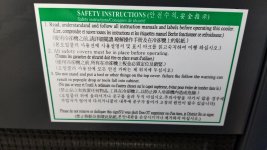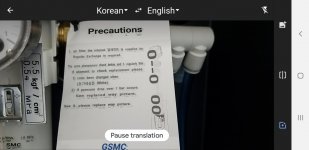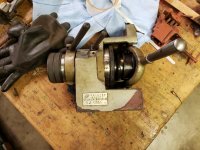How to install the app on iOS
Follow along with the video below to see how to install our site as a web app on your home screen.
Note: This feature may not be available in some browsers.
You are using an out of date browser. It may not display this or other websites correctly.
You should upgrade or use an alternative browser.
You should upgrade or use an alternative browser.
Is this Japanese writing or Chinese writing?
- Thread starter setlab
- Start date
- Replies 24
- Views 3,509
Rick Finsta
Stainless
- Joined
- Sep 27, 2017
So... this is my understanding based on some family that lives in Japan. The Japanese use a Chinese-based Kanji and also use a more modern version. If that is older Chinese Kanji, it could be either Chinese or Japanese.
eKretz
Diamond; Mod Squad
- Joined
- Mar 27, 2005
- Location
- Northwest Indiana, USA
Just looking at the unit itself I would tend to guess Taiwanese or Japanese. I would investigate that little planet logo, that will probably be your best bet if you want to figure out who made it.
Edit: Google Translate had this to say:
"People's Republic of China Yantai Machine Tool Accessories Factory OF331000 vertical grading division large family: center height 4 "factory number NO58"
So, Chinese writing.
Edit: Google Translate had this to say:
"People's Republic of China Yantai Machine Tool Accessories Factory OF331000 vertical grading division large family: center height 4 "factory number NO58"
So, Chinese writing.
L Vanice
Diamond
- Joined
- Feb 8, 2006
- Location
- Fort Wayne, IN
I see only Chinese characters. Japanese uses all the Chinese characters, but adds 49 of their own characters, so many Japanese texts will include both Chinese and Japanese characters. The upper left and upper right characters in the top line spell middle kingdom, what the Chinese call their country, but that could be a coincidence. But many Chinese companies include the character for middle in their names. And I have seen that trademark on Chinese lathe chucks.
Larry
Larry
daryl bane
Titanium
- Joined
- Mar 12, 2002
- Location
- East Texas
I have a rotary table that I got at the now absorbed J&L Supply 15+? years ago, that has that exact label. It is Chinese...but maybe Taiwan as the quality is excellent.
eKretz
Diamond; Mod Squad
- Joined
- Mar 27, 2005
- Location
- Northwest Indiana, USA
See my edit above...I would bet on Made in Taiwan. Looks too nice to be an import from the mainland.
L Vanice
Diamond
- Joined
- Feb 8, 2006
- Location
- Fort Wayne, IN
See my edit above...I would bet on Made in Taiwan. Looks too nice to be an import from the mainland.
People's Republic of China is mainland China and Yantai is a city on the coast near Korea.
Larry
BoxcarPete
Stainless
- Joined
- Nov 30, 2018
- Location
- Michigan, USA
I see only Chinese characters. Japanese uses all the Chinese characters, but adds 49 of their own characters, so many Japanese texts will include both Chinese and Japanese characters. The upper left and upper right characters in the top line spell middle kingdom, what the Chinese call their country, but that could be a coincidence. But many Chinese companies include the character for middle in their names. And I have seen that trademark on Chinese lathe chucks.
Larry
To expand upon this, the Japanese language actually has three alphabets:
1. Hiragana, each character represents a single syllable (a, u, ke, chi, su, etc.). These are used for native Japanese words. A good way to tell if it is Japanese is to look for の, this is pronounced "no" and it is used to designate possessives and link concepts together, so it shows up pretty often. There is also nothing that looks anything like it in Chinese, so if you see one of those you are dealing with Japan.
2. Katakana, a similar set to Hiragana, but they are used only for borrowed words, things that come into the Japanese language from the outside. It's actually pretty common, and if you learn these you can pick out some funny stuff shoved into the middle of written Japanese sentences.
3. Kanji, as noted earlier in this thread, shares its roots with the traditional Chinese alphabet and is somewhat mutually comprehensive, except that the pronunciations will all be completely different.
eKretz
Diamond; Mod Squad
- Joined
- Mar 27, 2005
- Location
- Northwest Indiana, USA
People's Republic of China is mainland China and Yantai is a city on the coast near Korea.
Larry
Yes but that doesn't really mean anything. As I know you are well aware, many items are labeled with company name and HQ location, doesn't mean they are actually made there. If we could discover where factory number 58 was, we might have some useful info about where it was actually manufactured. There certainly are not going to be 58 factories from one company in Yantai.
BoxcarPete
Stainless
- Joined
- Nov 30, 2018
- Location
- Michigan, USA
Yes but that doesn't really mean anything. As I know you are well aware, many items are labeled with company name and HQ location, doesn't mean they are actually made there. If we could discover where factory number 58 was, we might have some useful info about where it was actually manufactured. There certainly are not going to be 58 factories from one company in Yantai.
Unless "N0580" is a serial number, of a part, and not a factory?
eKretz
Diamond; Mod Squad
- Joined
- Mar 27, 2005
- Location
- Northwest Indiana, USA
Unless "N0580" is a serial number, of a part, and not a factory?
Possible, but then "factory" would be hanging down there all by itself after 'height 4" ' - not likely. And yes, 580 not 58, so that makes it even less likely that the factory is in Yantai I'd think. But this is all conjecture regardless. We'll probably never know for sure.
BoxcarPete
Stainless
- Joined
- Nov 30, 2018
- Location
- Michigan, USA
Possible, but then "factory" would be hanging down there all by itself after 'height 4" ' - not likely. And yes, 580 not 58, so that makes it even less likely that the factory is in Yantai I'd think. But this is all conjecture regardless. We'll probably never know for sure.
The point I was trying to make is that Google Translate is a useful tool, but not infallible. Especially with the Chinese language, you need to give concepts a little wiggle room. Where it says "Factory Number" you need to allow for that to be a concept involving both a number and a factory. A serial number fits the bill there, as a numbered part from that factory.
Just to set the issue to rest, I did my own google translate real-time image, and the algorithm couldn't quite decide if that line meant "Facory Number" or "Serial Number" as the live image moved a bit with my hand. From the additional context clue of those numbers being stamped in, I'd say for sure that serial number makes the most sense.
Not everything ever made in mainland China is junk. Lots of stuff that is junk is made there, but there are good people with talent, skill, dedication, and passion everywhere in the world. Downplaying or ignoring the possibility of that is what brings a person across the line from patriotism into nationalism.
billmac
Stainless
- Joined
- Oct 17, 2004
- Location
- Lancashire, UK
Definitely Chinese. Agree with Boxcar Pete's explanation, and the text is certainly not Japanese.
charlie gary
Stainless
- Joined
- Oct 4, 2009
- Location
- near Seattle, Washington, USA
My Japanese wife says Chinese.
Lewie
Cast Iron
- Joined
- Jun 7, 2018
- Location
- Albuquerque NM
The best source of any translation. :-)My Japanese wife says Chinese.
...lewie...
G
guest
Guest
I agree, the label is clearly Chinese.To expand upon this, the Japanese language actually has three alphabets:
1. Hiragana, each character represents a single syllable (a, u, ke, chi, su, etc.). These are used for native Japanese words. A good way to tell if it is Japanese is to look for の, this is pronounced "no" and it is used to designate possessives and link concepts together, so it shows up pretty often. There is also nothing that looks anything like it in Chinese, so if you see one of those you are dealing with Japan.
2. Katakana, a similar set to Hiragana, but they are used only for borrowed words, things that come into the Japanese language from the outside. It's actually pretty common, and if you learn these you can pick out some funny stuff shoved into the middle of written Japanese sentences.
3. Kanji, as noted earlier in this thread, shares its roots with the traditional Chinese alphabet and is somewhat mutually comprehensive, except that the pronunciations will all be completely different.
Your post really takes be back. I had 8 years of Japanese growing up. We were allowed to test out of English in school at the beginning of each year- if you met grade level English, you could opt for Japanese instead. I did that every year, 1st through 8th grades.
The phonetic alphabet- Hiragana, is considered the elementary level alphabet. That's as far as I ever got, lol. The other thing that's interesting about Japanese is that the consonants are combined with the vowel sounds. There are 5 vowel sounds, so it goes: ah,ee,oo,eh,o, then ka,ke,ku,keh,ko, sha,she,shu,sheh,sho, etc.
There is one exception- the sound "nnn". It's only found at the end of the word. The English word word "pen" is "pon" in Japanese and made of the "po" and "nnn" characters. All Japanese words end with either the "n" sound, or a vowel.
Also names: Japanese surnames names are always multi-syllables. "Kawasaki". Chinese surnames names are single syllable: "Xi", "Deng", "Wang". etc.
I lost my Japanese from not using it, but several years back I took a group of Japanese on a fishing trip, and it surprised me how much I still understood.
Jaxian
Stainless
- Joined
- Feb 24, 2013
- Location
- Santa Cruz
I didn't know Google translate could read pictures ��
For those who don't know about this I can not stress how useful this function is.
I have a Doosan CNC and it has writing in Korean, Chinese and Japanese depending on the component I am reading the tag on. Often all on one warning sticker.
If you download the Google Translate app, then download the specific language if you want to do a visual translate then all you have to do is get the text you want translated in front of the camera and it magically translates.
I swear it's like magic. I will go try to get a screen capture of it doing it's thing and attach it to my post. Can not recommend it enough if you just want a quick translation of a menu or manual or data plate or sign.
EDIT:
This is on the spindle chiller on my Doosan. It has English, French, Chinese and Koren writing on each line. Notice the Korean line is translated.


A tag in Korean on one of the air filters:


Note that it isn't static. As you stand there it will be constantly trying to amend the translation so you can slowly get slightly different results by just keeping it in the frame.
EmGo
Diamond
- Joined
- Apr 14, 2018
Late to the party but def Chinese. Yantai is a cool little place (little for China, probaly just a few million.) West Coast Marine / Mediterranean climate, not as flat as most of the east coast, not as humid in summer, a two hour ferryboat ride from Korea if you crave pickles ...
That's an older part, btw. Newer stuff has nicer labels and a better finish. If you go to tool shws in China you'll see externals that look every bit as good as the Taiwanian or Jap stuff. Now if they'd just put a few more rmb into the internals ...
But I recently saw a vmc with linear motors I wouldn't mind having. Quiet and fast ! How quiet it was was a surprise. Ballscrews are noisy.
That's an older part, btw. Newer stuff has nicer labels and a better finish. If you go to tool shws in China you'll see externals that look every bit as good as the Taiwanian or Jap stuff. Now if they'd just put a few more rmb into the internals ...

But I recently saw a vmc with linear motors I wouldn't mind having. Quiet and fast ! How quiet it was was a surprise. Ballscrews are noisy.
L Vanice
Diamond
- Joined
- Feb 8, 2006
- Location
- Fort Wayne, IN
As I mentioned, the trade mark looked like one I had seen on a Chinese lathe chuck that I bought several decades ago. The chuck is still in the box and I took some pictures of the writing. And I played with my cool new toy, Google Translate for smart phones. GT says the trade mark says "Global." Note that the box has a different company name and location than the indexer. The "Global" trade mark may have applied to several government-owned factories back before privatization came into being.
The last picture shows the two characters for "middle kingdom" or "middle country," the Chinese name for China. "Middle" is a square divided by a vertical line, one of the easiest characters to remember. Just to add confusion, Chugoku, the southwest part of Japan's main island is written with the same two characters. But the characters are pronounced completely differently in Chinese and Japanese.
Larry





The last picture shows the two characters for "middle kingdom" or "middle country," the Chinese name for China. "Middle" is a square divided by a vertical line, one of the easiest characters to remember. Just to add confusion, Chugoku, the southwest part of Japan's main island is written with the same two characters. But the characters are pronounced completely differently in Chinese and Japanese.
Larry








